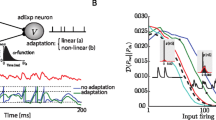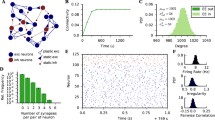Abstract
Recurrent neural networks of spiking neurons can exhibit long lasting and even persistent activity. Such networks are often not robust and exhibit spike and firing rate statistics that are inconsistent with experimental observations. In order to overcome this problem most previous models had to assume that recurrent connections are dominated by slower NMDA type excitatory receptors. Usually, the single neurons within these networks are very simple leaky integrate and fire neurons or other low dimensional model neurons. However real neurons are much more complex, and exhibit a plethora of active conductances which are recruited both at the sub and supra threshold regimes. Here we show that by including a small number of additional active conductances we can produce recurrent networks that are both more robust and exhibit firing-rate statistics that are more consistent with experimental results. We show that this holds both for bi-stable recurrent networks, which are thought to underlie working memory and for slowly decaying networks which might underlie the estimation of interval timing. We also show that by including these conductances, such networks can be trained to using a simple learning rule to predict temporal intervals that are an order of magnitude larger than those that can be trained in networks of leaky integrate and fire neurons






Similar content being viewed by others
Data availability
NA.
Code availability
Code is available on ModelDB. http://modeldb.yale.edu/267145
References
Compte, A., Brunel, N., Goldman-Rakic, P. S., & Wang, X. J. (2000). Synaptic mechanisms and network dynamics underlying spatial working memory in a cortical network model. Cerebral Cortex, 10, 910–923.
Egorov, A. V., Hamam, B. N., Fransén, E., Hasselmo, M. E., & Alonso, A. A. (2002). Graded persistent activity in entorhinal cortex neurons. Nature, 420, 173–178.
Fransén, E., Tahvildari, B., Egorov, A. V., Hasselmo, M. E., & Alonso, A. A. (2006). Mechanism of graded persistent cellular activity of entorhinal cortex layer V neurons. Neuron, 49, 735–746.
Fuster, J. M., & Alexander, G. E. (1971). Neuron activity related to short-term memory. Science, 173, 652–654.
Gavornik, J. P., & Shouval, H. Z. (2011). A network of spiking neurons that can represent interval timing: Mean field analysis. Journal of Computational Neuroscience, 30, 501–513.
Gavornik, J. P., Shuler, M. G. H., Loewenstein, Y., Bear, M. F., & Shouval, H. Z. (2009). Learning reward timing in cortex through reward dependent expression of synaptic plasticity. PNAS, 106, 6826–6831.
Goldman, M. S., Levine, J. H., Major, G., Tank, D. W., & Seung, H. S. (2003). Robust persistent neural activity in a model integrator with multiple hysteretic dendrites per neuron. Cerebral Cortex, 13, 1185–1195.
Goldman-Rakic, P. S. (1995). Cellular basis of working memory. Neuron, 14, 477–485.
Huertas, M. A., Hussain Shuler, M. G., & Shouval, H. Z. (2015). A Simple network architecture accounts for diverse reward time responses in primary visual cortex. Journal of Neuroscience, 35, 12659–12672.
Jin, D. Z., Ramazanoğlu, F. M., & Seung, H. S. (2007). Intrinsic bursting enhances the robustness of a neural network model of sequence generation by avian brain area HVC. Journal of Computational Neuroscience, 23, 283.
Koulakov, A. A., Raghavachari, S., Kepecs, A., & Lisman, J. E. (2002). Model for a robust neural integrator. Nature Neuroscience, 5, 775–782.
Lacinova, L. (2005). Voltage-dependent calcium channels. General Physiology and Biophysics, 24(1), 1–78.
Marder, E., Abbott, L. F., Turrigiano, G. G., Liu, Z., & Golowasch, J. (1996). Memory from the dynamics of intrinsic membrane currents. PNAS, 93, 13481–13486.
Namboodiri, V. M. K., Huertas, M. A., Monk, K. J., Shouval, H. Z., & Hussain Shuler, M. G. (2015). Visually cued action timing in the primary visual cortex. Neuron, 86, 319–330.
O’Malley, J. J., Seibt, F., Chin, J., & Beierlein, M. (2020). TRPM4 conductances in thalamic reticular nucleus neurons generate persistent firing during slow Oscillations. Journal of Neuroscience, 40, 4813–4823.
Rahman, J., & Berger, T. (2011). Persistent activity in layer 5 pyramidal neurons following cholinergic activation of mouse primary cortices. European Journal of Neuroscience, 34, 22–30.
Renart, A., Brunel, N., & Wang, X. J. (2004). Mean-field theory of irregularly spiking neuronal populations and working memory in recurrent cortical networks. Computational Neuroscience, 14, 431–490.
Renart, A., Moreno-Bote, R., Wang, X. J., & Parga, N. (2006). Mean-driven and fluctuation-driven persistent activity in recurrent networks. Neural Computation, 19, 1–46.
Shouval, H. Z., & Gavornik, J. P. (2011). A single spiking neuron that can represent interval timing: Analysis, plasticity and multi-stability. Journal of Computational Neuroscience, 30, 489–499.
Shuler, M. G., & Bear, M. F. (2006). Reward timing in the primary visual cortex. Science, 311, 1606–1609.
Tegnér, J., Compte, A., & Wang, X. J. (2002). The dynamical stability of reverberatory neural circuits. Biological Cybernetics, 87, 471–481.
Volman, V., Gerkin, R. C., Lau, P. M., Ben-Jacob, E., & Bi, G. Q. (2007). Calcium and synaptic dynamics underlying reverberatory activity in neuronal networks. Physical Biology, 4, 91.
Wang, X. J. (1999). Synaptic basis of cortical persistent activity: the importance of NMDA receptors to working memory. Journal of Neuroscience, 19, 9587–9603.
Wang, X. J. (2002). Probabilistic decision making by slow reverberation in cortical circuits. Neuron, 36, 955–968.
Wang, M., Yang, Y., Wang, C. J., Gamo, N. J., Jin, L. E., Mazer, J. A., Morrison, J. H., Wang, X. J., & Arnsten, A. F. T. (2013). NMDA receptors subserve persistent neuronal firing during working memory in dorsolateral prefrontal cortex. Neuron, 77, 736–749.
Wimmer, K., Compte, A., Roxin, A., Peixoto, D., Renart, A., & De La Rocha, J. (2015). Sensory integration dynamics in a hierarchical network explains choice probabilities in cortical area MT. Nature Communications, 6, 1–13.
Winograd, M., Destexhe, A., & Sanchez-Vives, M. V. (2008). Hyperpolarization-activated graded persistent activity in the prefrontal cortex. Proceedings of the National Academy of Sciences, 105, 7298–7303.
Funding
NIH, R01 EB022891; ONR, N00014-16-1-2327.
Author information
Authors and Affiliations
Corresponding author
Ethics declarations
Conflict of interest
The authors declare no conflict of interest.
Additional information
Action Editor: Albert Compte
Publisher's Note
Springer Nature remains neutral with regard to jurisdictional claims in published maps and institutional affiliations.
Rights and permissions
About this article
Cite this article
Aksoy, T., Shouval, H.Z. Active intrinsic conductances in recurrent networks allow for long-lasting transients and sustained activity with realistic firing rates as well as robust plasticity. J Comput Neurosci 50, 121–132 (2022). https://doi.org/10.1007/s10827-021-00797-2
Received:
Revised:
Accepted:
Published:
Issue Date:
DOI: https://doi.org/10.1007/s10827-021-00797-2




